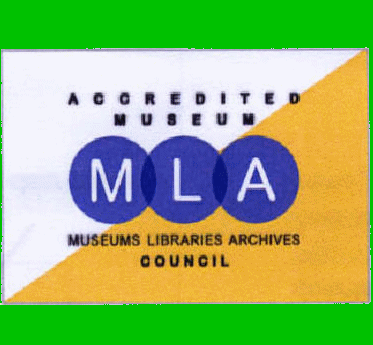Dates for your Diary
Throughout May
Coronation exhibition plus a Children’s Treasure Hunt to find the ‘Crown Jewels’!
Museum opening times
The Museum is open to the public, free of charge:
Thursday* to Saturday 10am – 1pm
April 100 Club
This month’s prize numbers were drawn by none other than our President, Jack Hanbury, who popped in for an impromptu visit at Springfest and the lucky winners are:-
No 18 Gillian Yemm £20
No 1 Nichola Hayward £10
If you would like to join our 100 club and be in with a chance of winning, it costs just £1 a month. Ask at the museum for further details
Coronation of King Charles III
No one does pageantry as well as the British and this month the world will be watching the historic crowning of King Charles and Queen Camilla. Since the death of Queen Elizabeth last September, there has been much planning for the event behind the scenes with the operation code-named ‘Golden Orb’. The ceremony is a very religious affair, much of which hasn’t changed in over 1000 years with the ceremony taking place at Westminster Abbey for the last 900 of those years and which since 1066 has been led by the Archbishop of Canterbury. At the Queen’s Coronation in 1953 there were over 8000 invited guests; this time there will be a more modest 2300 but many millions will be watching the televised event all around the globe. To mark this solemn occasion in British history, the museum will have an exhibition of royalty related items as well as a ‘Hunt the Crown Jewels’ Treasure Hunt for children.
Condolences
 It is my sad duty to report the death of Mr Ron Selway. Those of you who have been supporters of the museum for many years will no doubt remember Ron who was there supporting us through all the years when we were trying to secure the museum we have today - always at the lectures, at committee meetings (he served as a vice-chairman for many years), fund-raising events and attending the museum itself where he was well placed to 'meet and greet' visitors, given his interest in the museum and his knowledge of local history. Ron stepped back from active involvement in the museum some time ago as other interests took over but he will be remembered for his part in the history of the museum. We offer our sincere condolences to his family and friends at this sad time.
It is my sad duty to report the death of Mr Ron Selway. Those of you who have been supporters of the museum for many years will no doubt remember Ron who was there supporting us through all the years when we were trying to secure the museum we have today - always at the lectures, at committee meetings (he served as a vice-chairman for many years), fund-raising events and attending the museum itself where he was well placed to 'meet and greet' visitors, given his interest in the museum and his knowledge of local history. Ron stepped back from active involvement in the museum some time ago as other interests took over but he will be remembered for his part in the history of the museum. We offer our sincere condolences to his family and friends at this sad time.
Maundy Money Update
Following last month’s article on Maundy Money, Alyson Tippings, Destination Management Officer for Blaenau-Gwent CBC, got in touch to say that a gentleman from Tredegar was one of the few who received a set of Maundy coins from King Charles!
HMY BRITTANIA
The Royal Yacht Brittania was the 83rd such vessel and the second to bear the name Brittania, the first being a racing cutter built for the then Prince Edward in 1893. Built by John Brown & Co in Clydebank, Dunbartonshire, she was 412ft long, 55ft wide (126m x17m) and could reach a speed of 21.5 knots (25mph). Capacity wise, she could carry 250 guests and 270 crew of which 20 would be officers. And also on board whenever she was on duty away from home would be a Royal Marine Brass Band.
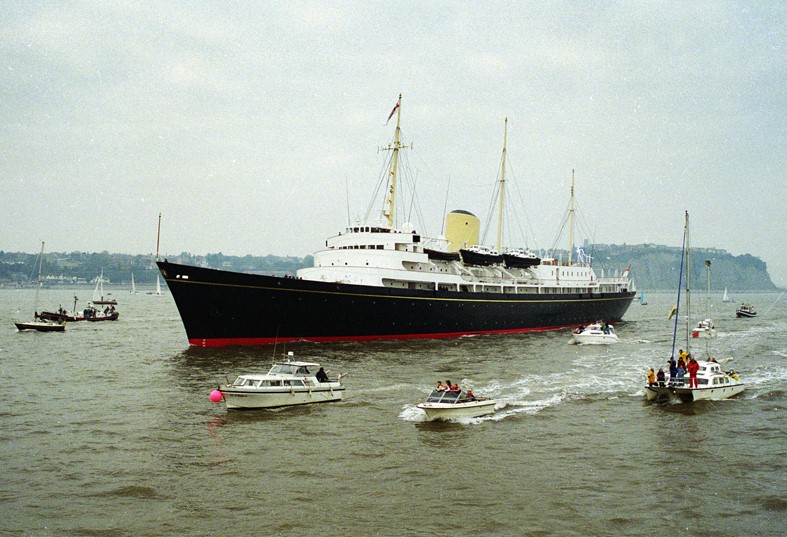
By Ben Salter from Wales - farewell Brittania
Uploaded by Oxyman, CC BY 2.0
She was commissioned in February 1952 by King George VI, just two days before he died, and took a year to build with the official launch being in April 1953 by Queen Elizabeth II. For her maiden voyage she carried the then Prince Charles and his sister, Anne, on a voyage from Portsmouth to Valletta, Malta, sailing on 14th April 1954 arriving at Valletta on 22nd April. There they met the Queen and Prince Phillip who were finishing their tour of the Commonwealth.
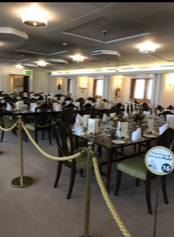 During her lifetime she circumnavigated the globe every year of her 43 years of service, travelling over 1 million miles and visiting 135 countries. And while some begrudged the £10m a year running costs, it should be noted that she earned this country over 100 times that amount in trade deals in her lifetime and was a majestic symbol and proud ambassador for this country, hosting over 900 State Banquets.
During her lifetime she circumnavigated the globe every year of her 43 years of service, travelling over 1 million miles and visiting 135 countries. And while some begrudged the £10m a year running costs, it should be noted that she earned this country over 100 times that amount in trade deals in her lifetime and was a majestic symbol and proud ambassador for this country, hosting over 900 State Banquets.
For the Royals it was a floating home-from-home, a place where they could holiday and relax away from the glare of the media. In time it earned the nick-name ‘The Love-Boat’ as it was the favoured place for Royals to honey-moon with the first being Princess Margaret and Lord Snowden, followed by Princess Anne and her first husband, Mark Phillips. They were followed by Prince Charles and Diana with the last honeymoon on board being that of Prince Andrew and Sarah Ferguson.
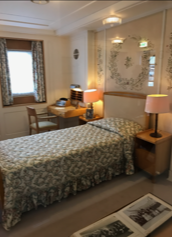 Britannia was designed to double as a hospital ship though she was never needed in that capacity. She did however play a big part in helping to evacuate British nationals and other Europeans from war-torn South Yemen in 1986. In several trips to and fro, she rescued over 1000 mainly British, Indian and Chinese who were transported to Djibouti in East Africa where they disembarked as the Royal Marine Brass Band played ‘God Save the Queen’ and ‘Rule Britannia’.
Britannia was designed to double as a hospital ship though she was never needed in that capacity. She did however play a big part in helping to evacuate British nationals and other Europeans from war-torn South Yemen in 1986. In several trips to and fro, she rescued over 1000 mainly British, Indian and Chinese who were transported to Djibouti in East Africa where they disembarked as the Royal Marine Brass Band played ‘God Save the Queen’ and ‘Rule Britannia’.
One thing that has only recently come to light is that, during the ‘Cold War’ of the 50s and 60s, where a nuclear war with Russia was always feared, Britannia was designated as a ‘floating bunker’ for the Royals to take refuge in should the need arise. It was also one of just five locations where Polaris nuclear missiles could be launched from should nuclear war break out. Britannia was decommissioned in 1997 and the Queen was visibly distressed at its decommissioning ceremony.
Today the ship is a floating museum, permanently moored at Ocean Terminal, Leith in Edinburgh where she is Scotland’s biggest tourist attraction. All clocks on board bear the time of 3.01pm, the time her Majesty left Britannia for the final time.
To read more on Brittania use this link
And to view a CH5 documentary on Britannia watch here
Interior photos thanks to reader Alison Williams and there are more to be found on our Facebook page.
Sally Murphy
Central Hotel Llanhilleth
Built in 1905 and sadly caught fire and damaged so much it had to be demolished in 2003; this building was my world until I was 18 years old. I had grandparents at the top of the hill in the Playhouse but I also had grandparents at the bottom of the hill in the Central Hotel! My grandparents at the Playhouse left when I was quite young but my family had the Central Hotel for 40 years and I spent many years in this wonderful building.
It was designed by Telford Evans and cost £6000 to build to help accommodate the rapid growth of population of Llanhilleth. Alfred Simmonds was the first landlord of this once magnificent building. In its latter year most would have thought the front was on Commercial Road, the main road through Llanhilleth but actually that was the back originally. The big double doors at the ‘back’ of the building was the original entrance with a beautiful mahogany staircase leading up to the other two floors and the foyer had a reception area, cloakrooms and round leather seat with big fern plant in the middle. Each side of the entrance were two big rooms, one had snooker tables and the other as ‘spit & sawdust’ bar and card tables. T his area around 1940 was cut off from the two top floors by a breeze block wall and used for various businesses including Baby clinic and Law Courts.
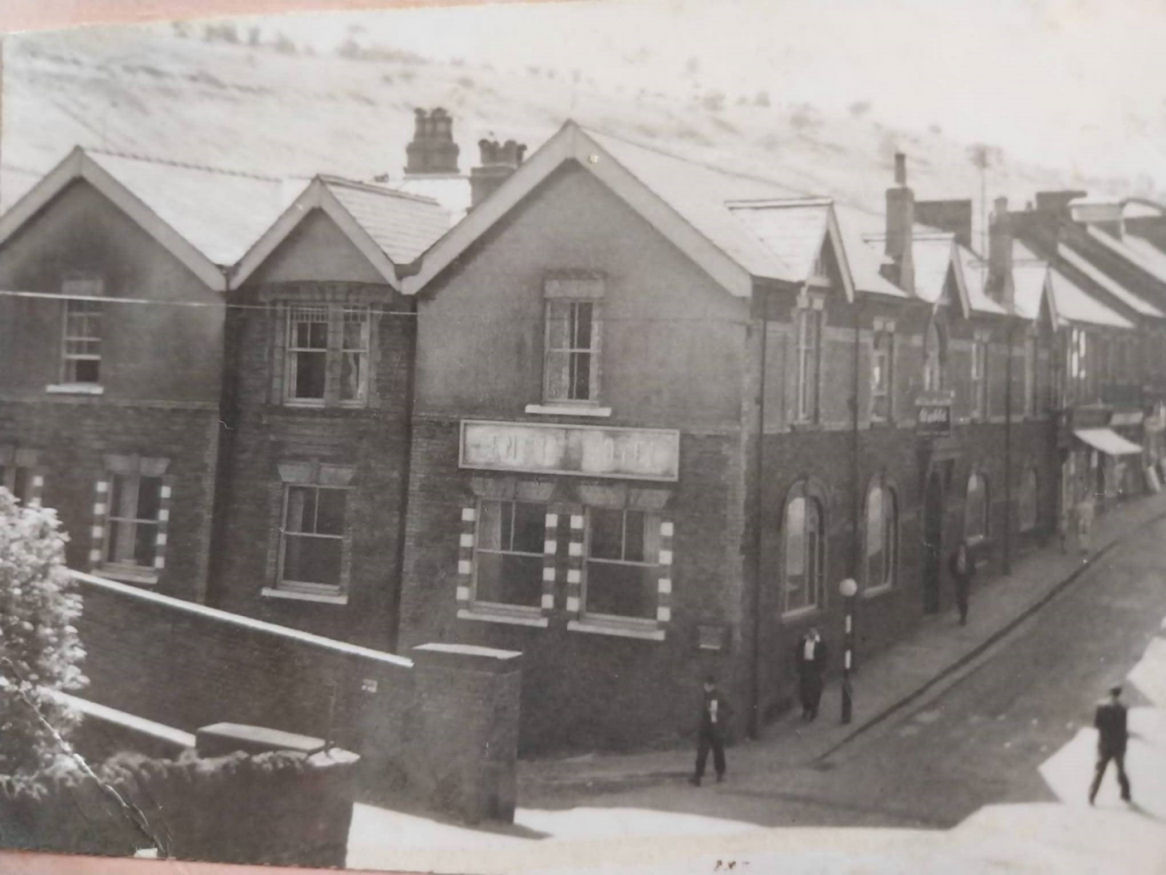
At the side of the double doors was a ‘garage’ door that was originally the coach house with coachman’s rooms, and inside an area for the horses to be rested and fed (this area became a garage and beer cellar). To the right of the coach area were servant’s quarters with small bedrooms and a kitchen (later the furnace and coke store). The upper or middle floor was a bar area with the counter running from one end of the building to the other with room for many types of entertainment. The top floor had living quarters for owners/managers and bedrooms for guests plus a wonderful room with a bay window for serving meals to the guests. The one side of the building on the top floor was for sports with boxing ring, shooting range and skittle alley.
According to rumour there were originally cellars underground at the side of the building but due to subsidence were filled in when the building was renovated and converted into two buildings around 1940 but I don’t know how true this story is!
During my life time the pub was my grandparents and I lived there for quite some time. The top floor was the family living quarters with kitchen, sitting room and 8 bedrooms plus the wonderful bay windowed dining room for any guests. There was a public telephone on the landing area and lined cupboard, bathroom and toilet around the landing area leading to the beautiful staircase to the lower floor. My favourite room was an area left from the shooting range I guess that we called the ‘play room’ with enough space to run around and have loads of fun!
The bar area was converted into front bars with lounge, Jug & Bottle (where older ladies would sit and chat) and bar area with darts, pool table, cards and domino games. At the other side of the building there were two big rooms for entertainment – reception room where a lot of wedding receptions and parties were held and the ‘Best Bar’ where entertainment was held like drum, piano and the ‘turn’ or singer on the stage!
Nowadays many newcomers or the younger generation would not even know it existed as the road to the new railway station and village square fills the space where this part of my life once stood.
Karen Pratley
The following article, written by retired Police Inspector Dave Moses, appeared in a recent edition of the Gwent Police Pensioners Association newsletter and Dave has kindly given his consent to it being reproduced here.
THE MOUSETRAP
For Christmas, my wife bought tickets for an afternoon performance of the Agatha Christie play, “The Mousetrap”, at Cardiff’s New Theatre. She assures me that she didn’t realise it was the last Saturday of the Six Nations and it had nothing to do with stopping me watching rugby all day! Having set the box to record the Welsh game, off we went to Cardiff, thoroughly enjoying the play. As we were leaving, I heard someone say that it was based on a real story.
For those that haven’t seen it, the play is based in a newly opened guest house and a number of the guests are linked to the murder of a child on a nearby farm many years earlier. Two brothers and their sister had been taken into care and fostered with the farmer and his wife. They starved and beat the children, with the one boy eventually being killed as a result of a beating from the farmer.
Having got home and watched the match (without anyone spoiling it and telling me score) I decided to see if the play had any links to an actual crime. Not only did I find that Agatha Christie had based the play on a real incident, but that the story starts in and is strongly linked to Newport…
In May 1944 Dennis, Terrence and Freddy O’Neil were living with their parents in Pill, Newport. The authorities in Newport decided to take the three boys into care, as it was felt that the parents couldn’t look after them properly.
On July 5th 1944, Dennis the eldest and Terrence, the middle boy, were fostered by Reginald and Esther Gough at Bank Farm, Shropshire, with Freddie being placed with Mr and Mrs Pickering who lived nearby. From the time Dennis and Terry moved to Bank Farm, they were starved and beaten daily by Mr Gough and made to work on the farm. On 8th January, Gough gave Dennis a severe beating with a knotted tree branch. He and Terry shared the same bed, with only a thin sheet on them.
The next morning, Terry couldn’t wake Dennis, whose body was cold. A doctor was called, but Dennis was dead, at 12 years of age and weighing just four stone. The police took Terry straight to hospital where he spent a number of months recovering. Gough and his wife were arrested and pleaded not guilty, but after the testimony of 10 year old Terry, Reginald Gough was found guilty of manslaughter and sentenced to six years in prison. His wife was sentenced to six months for child neglect.
These sentences caused a nationwide public outcry. Eventually on appeal, Reginald Gough was convicted of murder and his sentence extended to 10 years in prison. Almost immediately, the Home Secretary called the first ever public enquiry into child abuse. Agencies in both Newport and Shropshire were found to have made a string of errors and mistakes, with neither checking on the care the children received.
Dennis was laid to rest in St Woolos Cemetery, while Terry, after a number of care placements, returned to live in Newport. In 1947 Agatha Christie based a short radio play “Three Blind Mice” on this case. She later developed this into the stage play “The Mousetrap”, which opened in London in 1952 and is still running. It is in the Guinness Book of World Records as the longest running play ever.
Dave Moses
Branch Treasurer GPPA
Editor’s note
Many thanks to Dave for the above. I certainly did not appreciate that the story was based on actual events or that it had links to Wales.
Top Of Page
© Abertillery & District Museum 2023 